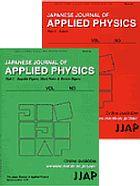|
Literature / Source Database:
Japanese Journal of Applied Physics
Description
Published by Japanese Society of Applied Physics.
| Title (short) |
Jpn. J. Appl. Phys. |
| Title (abbrev) |
JJAP |
| CODEN |
JJAPA5 |
| Languages |
English |
| Impact factor |
1.122 |
| Editor |
Yoshiaki Nakano (Univ. Tokyo) |
|
|

|
Status
active
Subject

Source type
Journal
Publisher
ISBN ISSN
0021-4922
E ISSN
1347-4065
First volume
1
Last volume
47+
Homepage
| Resources |
|
Availability |
|
|
|
|
|
| Text PDF |
 |
free access |
 |
| Text Html |
 |
for subscriber |
 |
| References |
 |
not available |
 |
| Abstracts |
 |
|
|
| TOC |
 |
|
|
|
|
|
|

Description
The Japanese Journal of Applied Physics (JJAP) is an international journal for the advancement and dissemination of knowledge in all fields of applied physics. The journal publishes articles dealing with the applications of physical principles as well as articles concerning the understanding of physics that have particular applications in mind. The journal not only covers all aspects of modern technology such as semiconductor devices including VLSI technology, photonic devices, superconductors, and magnetic recording but also covers other diverse areas such as plasma physics, particle accelerators, nanoscience and technology, and applied bioscience. Articles in interdisciplinary areas with potential technological implications are strongly encouraged. There is also a special section, "Selected Topics in Applied Physics" that highlights specific topics in applied physics. This section features rapidly developing current trends in the selected research area. Subjects Covered - Semiconductors
- Superconductors
- Magnetism
- Optics and Quantum Electronics
- Optical Properties of Condensed Matter
- Electrical Properties of Condensed Matter
- Structure and Mechanical and Thermal Properties of Condensed Matter
- Surfaces, Interfaces, and Films
- Nuclear Science, Plasmas, and Electric Discharges
- Atoms, Molecules, and Chemical Physics
- Instrumentation, Measurement, and Fabrication Technology
- General Physics
- Applied Bioscience
- Nano Science and Technologies
- Cross-Disciplinary Areas
|